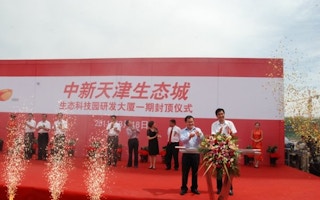Officials in China’s Tianjin Eco-City marked a milestone today with the completion of the first green building in its Eco-Business Park, dubbed as a symbol of the close ties between China and Singapore.
The Sino-Singapore Tianjin Eco-City Investment and Development Company (SSTEC) held a ceremony, known as ‘topping-out’, to mark the placement of the final structural piece of ‘The Landmark Building’ - the flagship building in the business park, and the first commercial building to be structurally completed.
SSTEC chief executive Ho Ton Yen said in a statement, “The topping-out ceremony for the Landmark Building is a significant milestone in the development of the Eco Business Park. With its many exciting green features, the Landmark Building will be an ideal location for companies to set up their offices in the Eco-City.”
Tianjin Eco-City is bilateral project between China and Singapore aimed at using private-sector investment to develop a model sustainable eco-city. The primary developer, SSTEC, is a joint venture between Singapore-listed Keppel Group and a Chinese consortium led by state-owned Tianjin TEDA.
Located in Northern China, the 30 kilometre square eco-city will house 350,000 residents and contain a 30 hectare business park that will act as a regional hub for domestic and international cleantech firms and other sustainable businesses. Developers aim to create over 15,000 jobs and new opportunities for innovation, research and development (R&D), and the commercialisation of sustainable urban solutions.
Renewable energy sources will supply at least 15 per cent of the eco-city’s energy demand.
The Tianjin Eco-City master plan dictates that every building is built to the Tianjin Eco-City’s Green Building Evaluation Standard (GBES), a local standard developed in 2009 from the Singapore Building and Construction Authority’s Green Mark scheme and the Chinese National Green Building Evaluation Standard. GBES buildings are rated according to both environmental impact and energy efficiency.
Aiming for silver level ratings from both GBES and the United-States based Leadership in Energy and Environmental Design system (LEED), the Landmark Building’s developers incorporated a wide range of environmentally-friendly features into the 19-storey building.
Green features for the building include passive design features, such as sunlight pipes that carry natural light into the underground parking areas, and solar thermal water heaters to supply over half of the building’s hot water requirements. The builders have included energy efficient technology such as heat recovery from exhaust air, a lighting on demand system from Dutch multinational Philips and energy efficient air-conditioning systems and lifts.
The building, which will house a mix of office space, R&D facilities, retail outlets and amenities for tenants, is connected to other areas of the eco-city through green walkways and public transport.
SSTEC’s Mr Ho said SSTEC hopes to attract both local and international companies to set up presence in the Landmark Building.
He announced that SSTEC will move their headquarters into the building once it was completed, calling the building “a symbol of the close cooperation between China and Singapore to build an Eco-City, which can be a model for sustainable urban development.”
SSTEC told Eco-Business they did not yet have a completion date for the new green building, but they expect it to be ready for occupancy in about a year’s time.

















